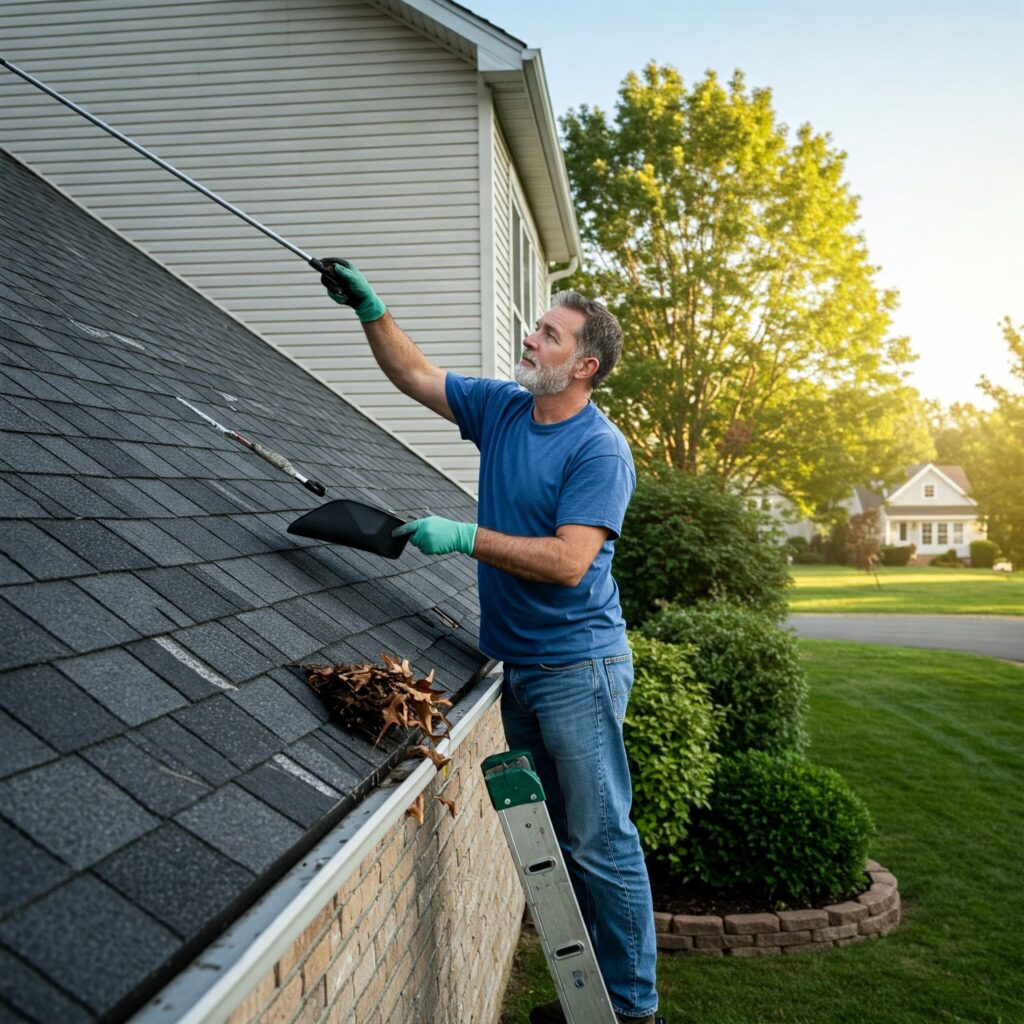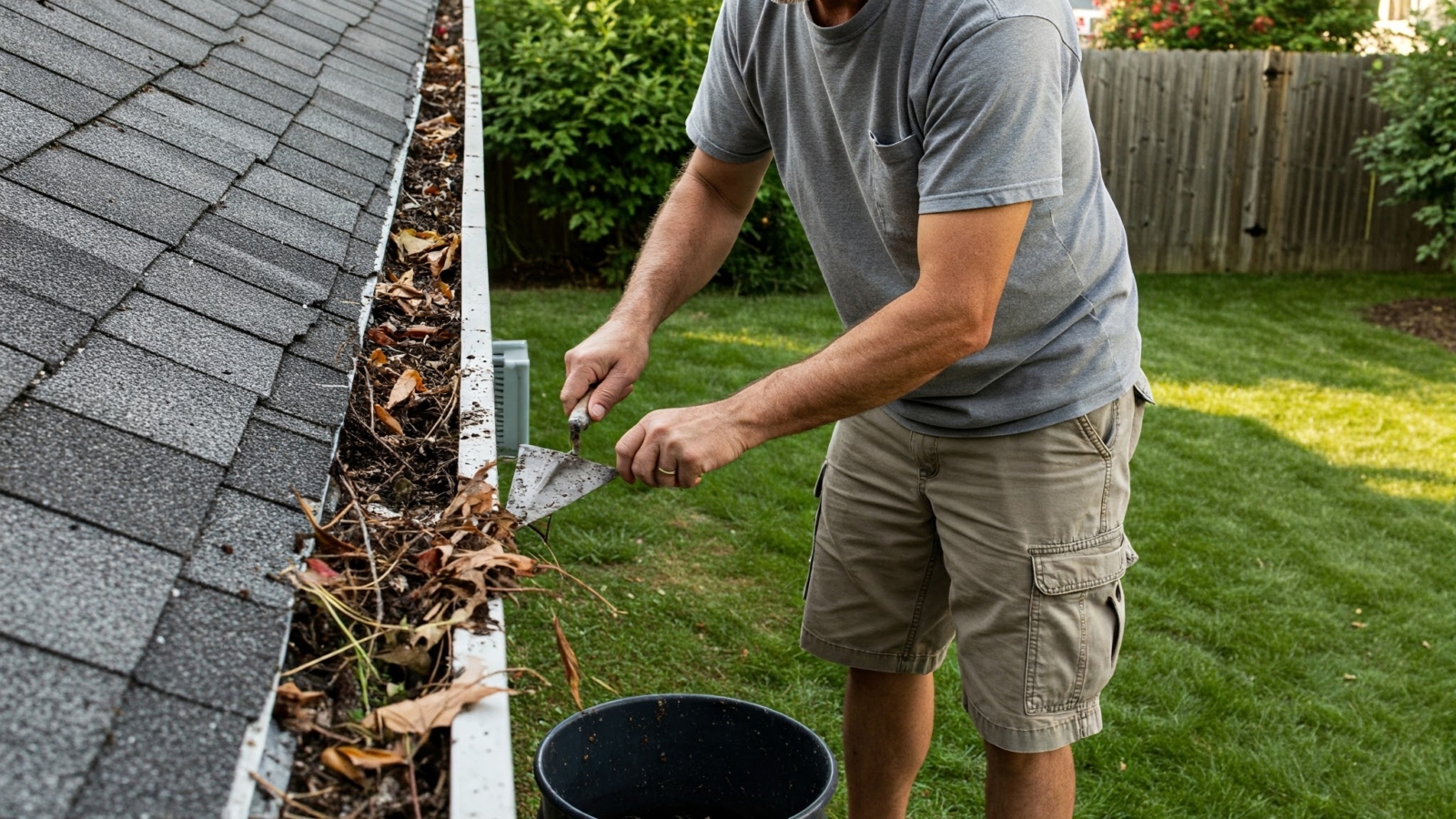Cleaning your gutters regularly is a crucial part of home maintenance, yet it’s often overlooked until problems arise. Understanding the best practices, tools, and techniques can save you from costly repairs due to water damage. In this guide, we’ll provide you with expert advice on “gutter cleaning how to,” ensuring your home’s gutter system remains efficient and damage-free.

Understanding the Importance of Regular Gutter Maintenance
Gutters may not be the most glamorous part of your home, but they play an essential role in protecting it from water damage. Regular gutter maintenance is akin to changing the oil in your car—it’s not exciting, but it’s crucial for optimal performance. Neglecting this task can lead to costly repairs and even compromise the structural integrity of your home.
“Regular gutter maintenance can prevent a host of issues, from roof leaks to foundation problems.” — National Association of Home Builders
Preventing Clogged Gutters and Water Damage
One of the most immediate benefits of regular gutter maintenance is preventing clogs that can cause water to overflow. This overflow can lead to water seeping into your basement, damaging your foundation, and even causing mold growth. The Gutters on your home are its first line of defense against such issues.
Extending Roof Lifespan
Your roof’s longevity is directly influenced by how well your gutters function. Water pooling due to clogged gutters can speed up wear and tear on roofing materials. This could lead you down the path to an untimely Roof Replacement, which is something no homeowner looks forward to.
Avoiding Common Mistakes
- Ignoring Regular Checks: It’s easy to forget about gutters until there’s an issue. Make it a habit to inspect them at least twice a year—ideally during spring and autumn.
- Using Unsafe Ladders: Always choose a ladder that’s appropriate for your roof height. Safety first!
- Overlooking Downspouts: Like the gutters themselves, downspouts need regular clearing to ensure proper drainage.
If this still sounds overwhelming, consider consulting a professional like our expert team at Statement Roofing for comprehensive gutter maintenance solutions. Remember, routine care today can prevent expensive headaches tomorrow.
Tools for Effective Gutter Cleaning
Embarking on a DIY gutter cleaning adventure? Lucky you! You’re in for some fun (and a little mess). But before you channel your inner handyman, make sure you’re armed with the right tools to transform your experience from a potential comedy of errors into a smooth operation. Here’s what you need:
The Essential Toolkit
- Sturdy Ladder: A safe ladder is paramount. Choose one that extends at least three feet above the roof edge for stability. Remember, gravity is not your friend if your ladder isn’t up to par.
- Gutter Scoop: A plastic scoop will be your best friend when dealing with leaves and debris. Metal scoops can damage your gutters, so plastic is the way to go.
- Garden Hose with Spray Nozzle: After scooping, flush out any residual debris with a garden hose equipped with a spray nozzle for effective cleanup.
- Gloves: Protect those hands! Gloves are essential to avoid injury or dealing with unpleasant surprises—like last autumn’s decaying leaves.
- Tarp or Drop Cloth: Lay these under your workspace to catch falling debris—it’s easier than sweeping up later!
Advanced Gutter Cleaning Gear
- Gutter Cleaning Wand: This telescopic wonder makes it easy to reach and clean gutters without climbing too high.
- Wet/Dry Vacuum Attachments: For those who prefer machinery, vacuum attachments can suck out even the most stubborn gunk.
- Pressure Washer Attachment: Powerful yet controlled water flow can eliminate buildup fast but be cautious—too much pressure may dislodge gutter components.
“Gutters should ideally be cleaned at least twice a year, in spring and fall.” — Bob Vila
If all this sounds like it might turn into an episode of ‘Gutters Gone Wild,’ consider calling in the pros. Our team at Statement Roofing offers expert advice and services that guarantee spotless gutters without lifting a finger on your end. Learn more about our offerings by exploring our comprehensive services page.
DIY Gutter Cleaning: Step-by-Step Guide
Rolling up your sleeves for DIY gutter cleaning can be as rewarding as it is essential for maintaining your home’s health. This simple yet crucial task ensures your gutters remain free of debris, preventing costly damages like water overflow and foundation erosion. Here’s a step-by-step guide to make your gutter cleaning a breeze.
1. Gather Your Tools
Before you begin, ensure you have the right gutter cleaning equipment. Here’s a quick checklist:
- Ladder: Ensure it’s sturdy and tall enough to reach your gutter safely. Remember, stability over speed!
- Gloves: A good pair of work gloves protects your hands from sharp debris and mucky buildup.
- Garden Trowel or Gutter Scoop: Useful for scooping out leaves and twigs.
- Buckets or Tarps: For collecting debris, unless you’re keen on fertilizing your lawn with soggy bits of leaves.
- Hose with Spray Nozzle: Ideal for flushing out stubborn dirt and ensuring water flows freely.
2. Ensure Safety First
Your safety is paramount when working at heights. Here’s how to make sure you’re not going viral for unintended reasons:
- Ladder Placement: Set it on a stable surface and avoid leaning too far to either side.
- Buddy System: Having someone spot you isn’t just for the gym—it’s essential here too!
- OSHA’s Ladder Safety Tips: Familiarize yourself with professional advice to minimize risks.
3. Begin Cleaning
Start from the downspout end and work towards the closed end of the gutter. Remove larger debris manually using your gloves or scoop, placing it into your bucket or tarp.
“An ounce of prevention is worth a pound of cure.” — Benjamin Franklin
4. Flush with Water
This step checks if everything’s flowing smoothly through the downspout. Attach a spray nozzle to your hose and flush each section, keeping an eye out for leaks or blockages which might need further attention.
5. Inspect Your Gutters
A visual inspection can help spot potential issues like rust spots, loose hardware, or sagging sections that may need tightening or repair. If this feels daunting, our expert team at Statement Roofing, stands ready to assist!
Semi-Annual Reminder: When is the Best Time?
The ideal times for cleaning gutters are late spring (after trees have shed their seeds) and early autumn (after most leaves have fallen). Regular maintenance keeps surprises at bay!
If DIY isn’t quite cutting it—or if you’d rather spend weekends doing literally anything else—consider reaching out to professionals who can keep things flowing smoothly without lifting a finger yourself!
Safety Precautions When Cleaning Gutters Yourself
Embarking on a DIY gutter cleaning adventure can be a rewarding endeavor, both for your wallet and your abode. However, it requires more than just donning a pair of gloves and grabbing the nearest ladder. Safety is paramount when you’re perched precariously between the earth and sky. Let’s dive into some essential safety tips to ensure your gutter cleaning how-to doesn’t turn into an emergency room visit.
1. Choose the Right Ladder
The ladder is your best buddy in this operation, so treat it with respect. A sturdy extension ladder is generally recommended for single-story homes, while a multi-section ladder can be beneficial for two-story structures. Ensure the ladder extends at least three feet above the roofline to provide stable footing.
- Check the ladder’s weight capacity to make sure it can support you along with your gear.
- Inspect for any loose screws or hinges before climbing.
- Place it on stable ground at a safe angle—about a 4:1 ratio (1 foot out for every 4 feet up).
2. Utilize Proper Tools and Equipment
Avoid the temptation of using makeshift tools like kitchen spoons or spades—gutter cleaning has its own set of heroes! Equip yourself with:
- Gutter scoop: This tool allows for efficient debris removal without damaging the gutter system.
- Garden hose: A powerful rinse helps reveal any remaining clogs while removing finer debris particles.
- Ladder stabilizer: This nifty gadget prevents the ladder from resting directly against your gutters, preventing damage and adding stability.
3. Dress Appropriately
You don’t need to dress like you’re auditioning for “Project Runway,” but attire matters here too!
- Non-slip shoes: Footing can be treacherous on ladders or roofs; choose footwear with good grip.
- Gloves: Protect your hands from sharp debris, insects, and other unpleasant surprises lurking within those gutters.
- Safety glasses: Keep errant twigs or leaves—and water splashes—out of your eyes.
“Safety doesn’t happen by accident.”
4. Be Mindful of Weather Conditions
Your DIY mission should always heed Mother Nature’s schedule. Avoid cleaning gutters during wet conditions or high winds as these significantly increase slip risks.
5. Stay Cognizant of Your Surroundings
If you’re working solo, inform someone nearby that you’ll be climbing up high—even Superman had backup! Maintain awareness regarding power lines; electricity isn’t something you’d want as an unexpected ally during gutter maintenance.
Treat gutter cleaning with respect and caution—it’s not just about aesthetics but also protecting your home from water damage. Follow these simple yet effective safety precautions to ensure that each season’s maintenance task goes off without any hitches—or slips!
The Debate: Professional vs DIY Gutter Cleaning?
When it comes to gutter cleaning how to, homeowners often find themselves at a crossroads: should they take the DIY route or hire professionals? Each option has its merits and pitfalls, and your decision may depend on a variety of factors including time, budget, and your comfort level with scaling heights. Let’s break it down.
DIY Gutter Cleaning: Roll Up Your Sleeves
- Cost-Effective: One of the primary reasons homeowners opt for DIY is the cost savings. The expense usually only involves purchasing tools for gutter cleaning such as a sturdy ladder, gloves, and a bucket.
- Flexible Schedule: You set your own timetable. Whether it’s early morning or late afternoon, you decide when to tackle this crucial home maintenance task.
- A Sense of Accomplishment: There’s no feeling quite like looking up at your freshly cleaned gutters knowing you did it yourself.
However, DIY isn’t without its risks. According to the National Safety Council, over 500,000 ladder-related injuries occur each year in the United States. So, mastering safe ladder use for gutter cleaning is not just optional—it’s essential.
Professional Gutter Cleaning: Leave It to the Experts
- Expertise and Equipment: Professionals bring years of experience and specialized equipment that ensure gutters are cleaned thoroughly and efficiently. They know effective techniques for removing debris from gutters without causing damage.
- Saves Time and Hassle: Hiring experts frees up your weekend plans. Instead of spending hours on a ladder, you can focus on activities you enjoy more.
- Safety First: Professional services minimize risk of injury by employing trained personnel who follow safety precautions for rooftop work diligently.
If you’re located in Indianapolis or nearby areas, you might consider enlisting help from our team at Statement Roofing’s gutter experts. Our professional services ensure your gutters function optimally all year round.
“The best time for gutter cleaning is during late spring and early autumn when leaves are most likely to clog gutters.”
The choice between DIY and hiring professionals ultimately hinges on your personal circumstances. If you’re confident with ladder work and have some spare time, DIY could save you money. On the other hand, if safety concerns outweigh cost savings or you’re simply too busy, professional gutter cleaning might be the best way to clean gutters effectively while ensuring peace of mind.
Best Practices for Ongoing Gutter Maintenance and Care
Maintaining clean and functional gutters is akin to keeping your car’s engine running smoothly—neglect it, and you’re bound to face costly repairs. While professional services are always available, adopting some best practices can keep your gutters in tip-top shape throughout the year.
1. Schedule Regular Inspections
- Seasonal Checks: The best time for gutter cleaning is typically in the spring and fall. During these seasons, debris is more likely to accumulate due to shedding leaves and spring blooms.
- Post-Storm Assessments: After a heavy rain or windstorm, inspect your gutters for clogs or damage caused by flying debris.
2. Implement Safe Ladder Use
Ladder injuries are all too common when homeowners decide to DIY their gutter cleaning. Ensure you:
- Choose the Right Ladder: Pick a ladder that extends three feet above the roof edge for stability.
- Avoid Overreaching: Always reposition your ladder rather than stretching too far.
3. Utilize Efficient Cleaning Techniques
- The Scoop and Drop Method: Use a plastic scoop to remove debris, dropping it onto a tarpaulin below for easy disposal.
- Splashless Flushing: Once cleared of debris, use a garden hose to flush out any remaining dirt, ensuring downspouts are draining properly.
4. Invest in Quality Gutter Guards
If you’re tired of constant cleaning, consider installing gutter guards. These handy tools help prevent blockages by allowing water through while keeping debris out.
“An ounce of prevention is worth a pound of cure.” — Benjamin Franklin’s advice resonates perfectly with gutter maintenance.”
5. Eco-Friendly Cleaning Options
Avoid harsh chemicals when scrubbing downpipes; instead opt for vinegar or dish soap mixed with water for an environmentally friendly clean-up.
For those in Indianapolis still pondering whether to tackle this project or call in professionals, our expert roofing contractors offer comprehensive services that ensure your home’s system remains unclogged and healthy all year round!
P.S.—If you find roof heights dizzying or simply prefer ground-level activities like gardening, leaving gutter maintenance to experts might be the wiser choice!
Conclusion:
Maintaining clean gutters is essential in protecting your home from potential water damage. By following this guide, you can perform effective DIY maintenance or decide when it’s time to call in the professionals. Remember, safety comes first, so equip yourself with the right tools and knowledge before embarking on any rooftop task.


